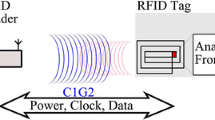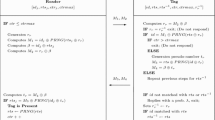Abstract
Radio Frequency Identification (RFID) Technology is a contactless automatic identification technology using radio frequency. For this RFID technology to be widely spread, the problem of privacy invasion should be solved. There are many research works in progress to solve the RFID privacy problems. Most of works for solving this problem have focused on developing light-weight cryptographic modules which can be embedded into RFID tags, but some of them used a proxy agent approach that control communications between the tag and the reader for protecting user privacy. The later approach is very useful and practical in terms of manufacturing low-cost tag hardware. However, all schemes of this approach have some problems in ownership transfer and forgery detection. In this paper, we are focusing on the proxy agent approach and we suggest an advanced agent scheme that guarantees not only privacy protection but also forgery detection. And our scheme is more scalable than other agent schemes so far.
Similar content being viewed by others
References
Anderson, R. J., & Kuhn, M. G. (1997) Low cost attacks on tamper resistant devices. In B. Christianson, B. Crispo, T. M. A. Lomas, & M. Roe (Eds.), Security Protocols, 5th International Workshop, Lecture Notes in Computer Science (Vol. 1361, pp. 125–136). Paris, France: Springer-Verlag.
Avoine, G., & Oechslin, P. (2005). RFID traceability: A multilayer problem. In A. Patrick & M. Yung (Eds.), Financial cryptography – FC’05, Lecture Notes in Computer Science (Vol. 3570, pp. 125–140). Roseau, The Commonwealth Of Dominica, IFCA, Springer-Verlag.
Feldhofer, M., Dominikus, S., & Wolkerstorfer, J. (2004). Strong authentication for RFID systems using the AES algorithm. In M. Joye & J. J. Quisquater (Eds.), Workshop on Cryptographic Hardware and Embedded Systems – CHES 2004, Lecture Notes in Computer Science (Vol. 3156, pp. 357–370). Boston, MA, USA: IACR, Springer-Verlag.
Feldhofer, M., & Rechberger, C. (2006). A case against currently used hash functions in RFID protocols. Printed handout of Workshop on RFID Security – RFIDSec 06.
Finkenzeller K. (2003). RFID handbook (2nd ed). Wiley, Chichester
Golle, P., Jakobsson, M., Juels, A., & Syverson, P. (2004). Universal re-encryption for mixnets. In T. Okamoto (Ed.), The Cryptographers’ Track at the RSA Conference – CT-RSA, Lecture Notes in Computer Science (Vol. 2964, pp. 163–178). San Francisco, CA, USA: Springer-Verlag.
Juels, A. (2004). Minimalist cryptography for low-cost RFID tags. In C. Blundo & S. Cimato (Eds.), International Conference on Security in Communication Networks – SCN 2004, Lecture Notes in Computer Science (Vol. 3352, pp. 149–164). Amalfi, Italia: Springer-Verlag.
Juels, A. (2005). RFID security and privacy: A research survey. Manuscript.
Juels, A., Syverson, P., & Bailey, D. (2005). High-power proxies for enhancing RFID privacy and utility. In Workshop on Privacy Enhancing Technologies - PET 2005. Dubrovnik, Croatia.
Juels, A., & Weis, S. (2005). Authenticating pervasive devices with human protocols. In: V. Shoup (Ed.), Advances in Cryptology – CRYPTO’05, Lecture Notes in Computer Science (Vol. 3126, pp. 293–308). Santa Barbara, CA, USA: IACR, Springer-Verlag.
Katz, J., & Sun Shin, J. (2006). Parallel and concurrent security of the HB and HB+ protocols. In S. Vaudenay (Ed.), Advances in Cryptology – EUROCRYPT’06, Lecture Notes in Computer Science. Saint Petersburg, Russia: IACR, Springer-Verlag.
Kim, S. C., Yeo, S. S., & Kim, S. K. (2006). MARP: Mobile agent for rfid privacy protection. In J. Domingo-Ferrer, J. Posegga, & D. Schreckling (Eds.), International Conference on Smart Card Research and Advanced Applications – CARDIS, Lecture Notes in Computer Science. Tarragona, Spain: IFIP, Springer-Verlag.
Knospe H. and Pohl H. (2004). RFID security. Information Security Technical Report, 9(4): 39–50
Ohkubo, M., Suzuki, K., & Kinoshita, S. (2003). Cryptographic approach to “privacy-friendly” tags. In RFID Privacy Workshop. MIT, MA, USA.
Piramuthu, S. (2006). HB and related lightweight authentication protocols for secure RFID tag/reader authentication. In Collaborative Electronic Commerce Technology and Research – CollECTeR 2006. Basel, Switzerland.
Rieback, M., Crispo, B., & Tanenbaum, A. (2005). RFID guardian: A battery-powered mobile device for RFID privacy management. In C. Boyd & J. M. González Nieto (Eds.), Australasian Conference on Information Security and Privacy – ACISP’05, Lecture Notes in Computer Science (Vol. 3574, pp. 184–194). Brisbane, Australia: Springer-Verlag.
Rieback, M., Gaydadjiev, G., Crispo, B., Hofman, R., & Tanenbaum, A. (2006). A platform for rfid security and privacy administration. In USENIX/SAGE Large Installation System Administration Conference—LISA’06. Washington DC, USA.
Sarma S., Weis S. and Engels D. (2003). Radio-frequency identification: security risks and challenges. Cryptobytes, RSA Laboratories 6(1): 2–9
Weis, S. (2005). Security parallels between people and pervasive devices. In International Workshop on Pervasive Computing and Communication Security – PerSec 2005 (pp. 105–109). IEEE, IEEE Computer Society Press, Kauai Island, Hawaii, USA.
Weis, S., Sarma, S., Rivest, R., & Engels, D. (2003). Security and privacy aspects of low-cost radio frequency identification systems. In D. Hutter, G. Müller, W. Stephan, & M. Ullmann (Eds.), International Conference on Security in Pervasive Computing – SPC 2003, Lecture Notes in Computer Science (Vol. 2802, pp. 454–469). Boppard, Germany: Springer-Verlag.
Yeo, S. S., & Kim, S. K. (2005). Scalable and flexible privacy protection scheme for RFID systems. In R. Molva, G. Tsudik, & D. Westhoff (Eds.), European Workshop on Security and Privacy in Ad hoc and Sensor Networks – ESAS’05, Lecture Notes in Computer Science (Vol. 3813, pp. 153–163). Visegrad, Hungary: Springer-Verlag.
Yeo, S. S., Sakurai, K., Cho, S., Yang, K., & Kim, S. K. (2007). Forward secure privacy protection scheme for rfid system using advanced encryption standard. In P. Thulasiraman, X. He, T. L. Xu, M. K. Denko, R. K. Thulasiram, & L. T. Yang (Eds.), ISPA Workshops, Lecture Notes in Computer Science (Vol. 4743, pp. 245–254). Niagara Falls, Canada: Springer.
Author information
Authors and Affiliations
Corresponding author
Rights and permissions
About this article
Cite this article
Yeo, SS., Kim, SC., Kim, S.K. et al. Protecting Your Privacy with a Mobile Agent Device in RFID Environment. Wireless Pers Commun 51, 165–178 (2009). https://doi.org/10.1007/s11277-008-9597-8
Published:
Issue Date:
DOI: https://doi.org/10.1007/s11277-008-9597-8




